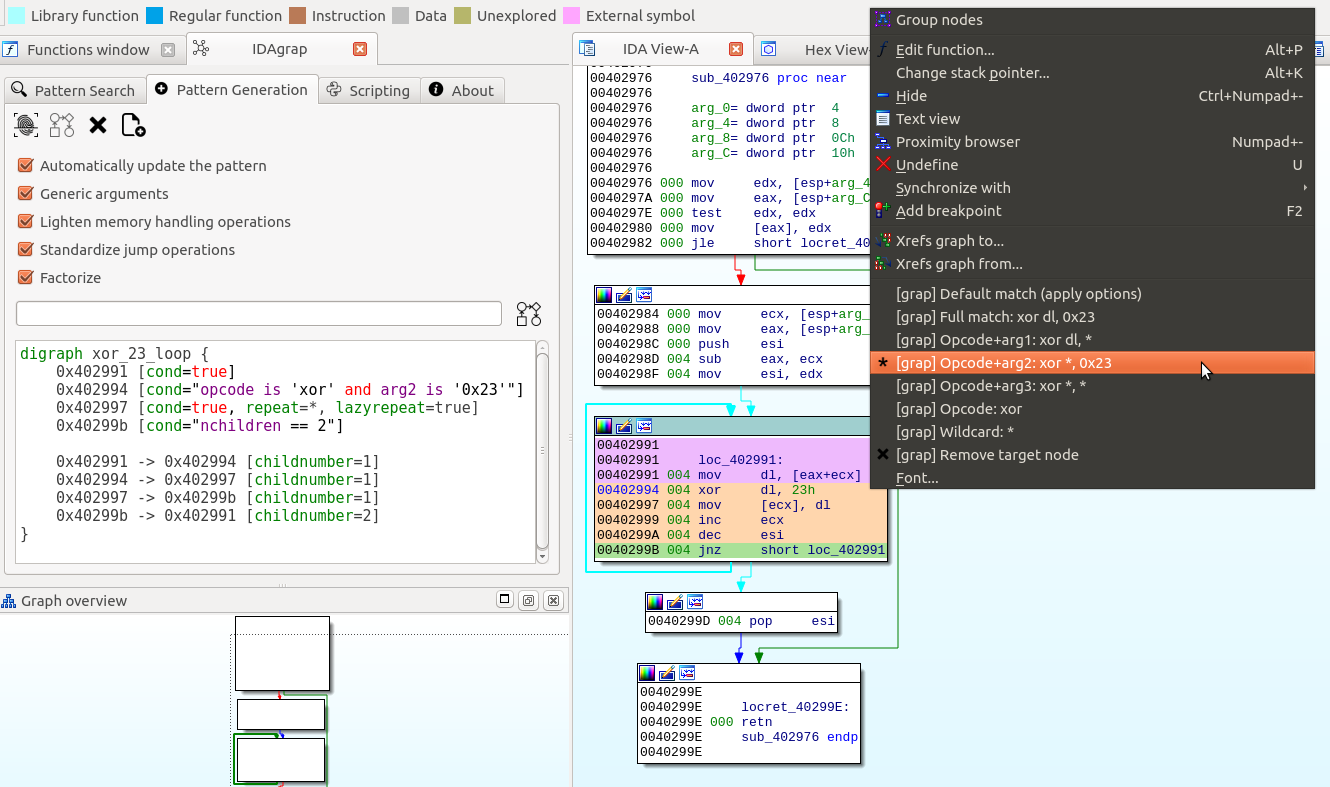grap takes patterns and binary files, uses a Casptone-based disassembler to obtain the control flow graphs from the binaries, then matches the patterns against them.
Patterns are user-defined graphs with instruction conditions ("opcode is xor and arg1 is eax") and repetition conditions (3 identical instructions, basic blocks...).
grap is available as a standalone tool with a disassembler and python bindings, and as an IDA plugin which takes advantage of the disassembly done by IDA and the reverser.
Support:
- Files: disassembly of PE, ELF and raw binary, further files should work within IDA
- Architecture: x86 and x86_64
This document describes how to build and install grap on a Linux distribution.
You may also read:
- WINDOWS.md: installing grap on Windows
- IDA.md: installation and usage instruction of the IDA plugin
Besides compilers (build-essential), the following dependencies must be installed:
- cmake
- bison
- flex
- libboost-regex-dev
- libboost-system-dev
- libboost-filesystem-dev
- libseccomp-dev
- python3-dev
- python3-pefile
- python3-pyelftools
- python3-capstone
- swig (version 3 or newer is mandatory)
Thus on Ubuntu / Debian, this should work :
sudo apt-get install build-essential cmake bison flex libboost-regex-dev libboost-system-dev libboost-filesystem-dev libseccomp-dev python3-dev python3-pefile python3-pyelftools python3-capstone swig
Please note that those were tested for the latest Ubuntu LTS (18.04.3). Packages may differ depending on your distribution.
The following commands will build and install the project:
mkdir build; cd build/as we advise you to build the project in a dedicated directorycmake ../src/; makewill build with cmake and makesudo make installwill install grap into /usr/local/bin/
SWIG might fail to find python3 if your default version is python2, this can be overcome by switching to python3 as default. For instance on Ubuntu:
sudo update-alternatives --install /usr/bin/python python /usr/bin/python3 10
The tool can be launched by using the following command:
$ grap [options] pattern test_paths
Below are a few examples of supported options:
grap -h: describes supported options
One can let grap infer a pattern from a string. Only few options are supported but this is useful for prototyping:
grap "opcode is xor and arg1 contains '['" (test.exe): look for a xor with a memory writegrap -v "sub->xor->sub" (test.exe): -v will output the path of the inferred pattern
Choose how the binaries are disassembled:
grap -od (pattern.grapp) samples/*: disassemble files in folder samples/ with no attempt at matchinggrap -f (pattern.grapp) (test.exe): force re-disassembling the binary, then matches it against pattern.grappgrap --raw (pattern.grapp) (test.bin): disassembling raw file (use --raw-64 for 64 bits binaries)
Control the verbosity of the output:
grap -q -sa (pattern.grapp) (samples/*.grapcfg): match disassembled files, show matching and non matching files, one per linegrap -m (pattern.grapp) (test.grapcfg): show all matched nodes
Choose where the disassembled file(s) (.grapcfg) are written; match multiple files against multiple patterns:
grap patterns/basic_block_loop.grapp -o ls.grapcfg /bin/ls: disassemble ls into ls.grapp and looks for basic block loopsgrap (pattern1.grapp) -p (pattern2.grapp) (test.exe): match against multiple pattern filesgrap -r -q patterns/ /bin/ -o /tmp/: disassemble all files from /bin/ into /tmp/ and matches them against all .grapp patterns from patterns/ (recursive option -r applies to /bin/, not to patterns/)
The following pattern detects a decryption loop consisting of a xor followed by sub found in a Backspace sample:
digraph decryption_md5_4ee00c46da143ba70f7e6270960823be {
A [cond=true, repeat=3]
B [cond="opcode is xor and arg2 is 0x11"]
C [cond="opcode is sub and arg2 is 0x25"]
D [cond=true, repeat=3]
E [cond="opcode beginswith j and nchildren == 2"]
A -> B
B -> C
C -> D
D -> E
E -> A [childnumber=2]
}
Note that pattern files can contain multiple pattern graphs.
You may find additional pattern examples in two directories:
- patterns/ contains a few patterns that can be useful on any binary such as a pattern to detect short loops or to detect a loop on basic blocks,
- examples/ contains patterns used against the Backspace malware (see examples/backspace_samples.md to obtain the binary samples).
On malware samples:
- Navigating malware samples with grap (CLI, IDA): https://yaps8.github.io/blog/grap_qakbot_navigation
- Automating function parsing and decryption (python bindings): https://yaps8.github.io/blog/grap_qakbot_strings
Python bindings usage:
- Python file demonstrating how to use bindings to analyze Backspace samples: examples/analyze_backspace.py
- Examples of IDApython scripting are integrated within the IDA plugin, you can see them here: https://yaps8.github.io/grap/html/scripting_css.html
You will find more documentation in the doc/ folder:
The syntax of pattern and test graphs is detailed in the file grap_graphs.pdf within the release section.
grap is licensed under the MIT license. The full license text can be found in LICENSE.



